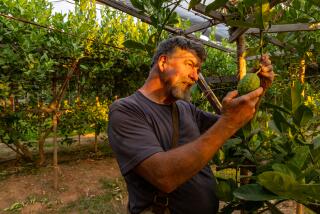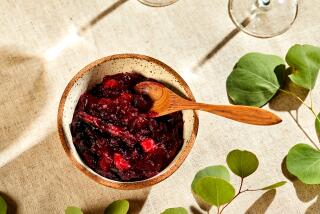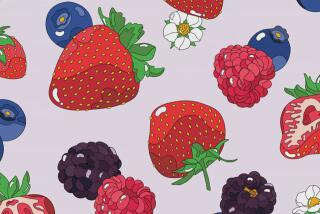Thanksgiving’s Crimson Tide
CHATSWORTH, N.J. — In the heart of the Pinelands when the leaves turn golden, the bogs become a crimson sea. And the bitter fruit bound for Thanksgiving tables around the country floats off the vine in gentle waves.
“It’s one of the most beautiful sights in the world,” says Holly Haines, bumping along in her pickup truck down the narrow, sandy roads that weave across her family’s cranberry bogs.
All around are signs of the harvest: workers wading knee-deep in red, pushing motorized reels that knock the fruit from the vine; others using giant yellow booms to corral the berries and suck them up conveyor belts into trucks.
There’s a rhythm to the work as the motors hum and the workers wade and the trucks rattle up and down. There’s a timeliness too. And not just because it’s a month before Thanksgiving. The berries must be harvested before the first frost, or the entire crop could be lost.
Haines leans into a crate of berries and picks one so dark it’s called an Early Black. She brushes away the small sticky oval-shaped leaves. “The deeper the color, the better the taste,” she says, popping the berry straight from the bog into her mouth.
It’s tart and acidic, much sharper than the sweetened version used in sauces. American Indians used to call it “ibimi” or bitter berry.
This Thanksgiving, Americans will devour about 80 million pounds of bitter berries, most of them in sauces made by Ocean Spray Cranberries Inc., the largest producer in the country.
The Haines family owns the biggest farm in New Jersey, 11,000 acres of Pineland, about 1,100 of them devoted to cranberries. Holly Haines knows the bogs like she knows her own brothers and sisters, knows their names and colors and secrets. Red Road. Deep Run. Bishop’s Mill. There’s even a bog named for her: Holly Bogs.
Bishop’s Mill is where a dozen men are working now. They form a watery chain, each walking a few paces behind the other, pushing machines that beat the berries from the floating vines. The leader is the only one without a machine. Instead, he pokes his way through the bog with two long sticks, searching for sudden drops in the level of the water or changes in the direction of the vines.
There’s an otherworldly sensation to wading through a crimson lake, bouncing over the spongy undergrowth as waves of berries tumble like marbles all around.
Even veteran farmhands marvel at the sight.
“When I first saw workers going into the red water, it looked almost scary. I thought, do I have to go in there?” says Carlos Baez, who cut sugar cane in his native Puerto Rico before starting work at the Haines farm 16 years ago.
*
Today, Baez knows the slope of every bog and the cut of every ditch. He sends pictures back to relatives in Puerto Rico. And he tells his children the story of how the cranberry got its name, how the pilgrims thought the arched neck and petals of the flowering pink plant resembled the neck and bill of a crane. They named it “craneberry,” which eventually became cranberry.
“It’s hard work when the water gets cold and the wind is blowing,” Baez says on a blustery day as berries lap against the side of the bog. “But it was much harder in the old days.”
Until about 40 years ago, cranberries were dry-harvested, scooped off the vines with large wooden combs that made for backbreaking work. By accident and experiment, farmers discovered that flooding the fields caused the berries to float upward, making them easier to pick. Today, most of the bogs in the main cranberry-producing states--New Jersey, Oregon, Wisconsin and Massachusetts--are flooded during the harvest.
Most berries wind up in giant bubbling caldrons, boiled into sauces and juices in the cook-pots of Ocean Spray. Cranberry sauce is easy to make--crushed berries, sugar and water, nothing else. The berries have a natural pectin that makes them gel.
For all their simplicity, cranberries are a fragile fruit that needsconstant care. From pollinating the plants with bees in summer, to sanding the bogs in winter, to the constant monitoring of water levels and temperatures, farming is a year-round effort. “Hard work and cranberry juice flowing through the veins,” says grower Stephen Lee, 87, a Haines neighbor.
Aggressive marketing doesn’t hurt. Cranberries have long been valued as nutritious, from the days when the Indians pounded them into a dried meat dish called pemmican, to modern studies showing they can lower the risk of urinary-tract infections and heart disease.
These days cranberries pop up in everything from fruit juices to ice cream to Craisins, a dried sweetened berry that looks like a crimson raisin. Each year cranberries fill some 5.5 million barrels, 100 pounds apiece, with New Jersey growers contributing a half million. The industry has never looked so rosy.
*
But the bogs have had hard times too. Lee’s son, Abbott, remembers the family heartbreak when his father had to dump the entire crop in 1959 after an herbicide scare on farms in Oregon and Washington.
Days before Thanksgiving, the secretary of health suggested that Americans “pass up on cranberries this year,” and they did--despite growers’ protests of a false alarm. Even the sight of Vice President Richard Nixon solemnly swallowing spoonfuls of sauce on national TV didn’t convince people that cranberries weren’t “cancer berries.”
“It was devastating,” says Abbott Lee, who was 9 at the time. “We watched our whole livelihood buried that year.”
It’s the good times on the bogs that Holly Haines, 42, remembers most. As the light fades on Bishop’s Mill, she points to the spot where her mother gathered berries for bouquets, to the dirt paths where she had raced her brothers and sisters on bikes, and to the crumbling stone oven where migrant workers once baked bread. Her best memories are here, she says, as a child munching freshly picked Early Blacks dipped in egg white and sugar.
As dusk falls, the workers pack up the machines and head home. They’ll be back the next day at sunrise. For now, the bogs turn silent and the crimson fades into a deep maroon.
More to Read
Sign up for The Wild
We’ll help you find the best places to hike, bike and run, as well as the perfect silent spots for meditation and yoga.
You may occasionally receive promotional content from the Los Angeles Times.






